 Food and Nutrition Sciences, 2013, 4, 1293-1300 Published Online December 2013 (http://www.scirp.org/journal/fns) http://dx.doi.org/10.4236/fns.2013.412166 Open Access FNS Bioavailability and Immunity Response in Broiler Breeders on Organically Complexed Zinc Supplementation Neeta Soni, Sumanta Kumar Mishra*, Rajakishore Swain, Abinash Das, Biswal Chichilichi, Kamdev Sethy Department of Animal Nutrition, College of Veterinary Science and Animal Husbandry, Orissa University of Agriculture and Tech- nology, Bhubaneswar, India. Email: *sumantkmishra@gmail.com Received September 17th, 2013; revised October 17th, 2013; accepted October 24th, 2013 Copyright © 2013 Neeta Soni et al. This is an open access article distributed under the Creative Commons Attribution License, which permits unrestricted use, distribution, and reproduction in any medium, provided the original work is properly cited. In accor- dance of the Creative Commons Attribution License all Copyrights © 2013 are reserved for SCIRP and the owner of the intellectual property Neeta Soni et al. All Copyright © 2013 are guarded by law and by SCIRP as a guardian. ABSTRACT Two hundred and sixty four broiler breeder hens of 32 weeks of age were distributed randomly in four dietary treat- ments. The dietary treatments were T0: Broiler breeder ration containing 40 ppm zinc (basal 29.8 ppm + 10.2 ppm inor- ganic zinc), T1: T0 + organic zinc (zinc methionine) @ 20 ppm, T2: T0 + organic zinc @ 40 ppm and T3: T0 + organic zinc @ 60 ppm. The experiment was continued from 32 to 48 weeks of age. At 48 weeks, the weight of lymphoid or- gans, zinc levels in organs and immunity response were determined. The faecal zinc level was determined at monthly interval. The weight lymphoid organs of different treatment groups (both organic and inorganic zinc fed groups) of the broiler breeders did not differ significantly (P > 0.05). The cellular immune response of breeder birds to PHA-P was significantly (P < 0.05) higher in group T3 than the rest of treated groups. The antibody titre to SRBC differed among the treated groups. The zinc content of serum of broiler breeders of all the groups did not differ significantly (P > 0.05) in all the periods of study. Zinc content in liver and tibia of broiler breeders in different dietary treatments of zinc dif- fered significantly (P < 0.05) with higher levels were obtained on increasing zinc concentration in the diet. The zinc level in the spleen and kidney of the broiler breeders in different dietary treatments did not differ significantly (P > 0.05). The average zinc content in the faeces of broiler breeder during 35 to 43 week of age did not differ significantly (P > 0.05) among the treated groups. At 48 weeks of age, zinc content of the faeces of T3 was found to be significantly (P < 0.05) higher than the rest of treated groups. Similarly, during the overall experimental period analysis, it was found that zinc levels in the faeces of T2 and T3 were significantly (P < 0.05) higher than T1 and T0. Keywords: Organic Zinc; Immunity; Bioavailability; Broiler Breeders 1. Introduction Zinc impacts immunity in poultry [1]. Zinc deficiency has been shown to decrease cellular immunity [2], thy- mus [3] and spleen development [4]. Zinc is important for proper disease resistance and its deficiency has re- sulted in bacteremia [5], parasitic infections [6] and al- teration in high-density lipoprotein cholesterol [7]. Zn- methionine provides a source of zinc with greater bio- logical availability than zinc from inorganic sources. Gill (1997) [8] reported that chelated (organic) minerals are more biologically available in animal digestive system than inorganic minerals and that perhaps resulted in less mineral excretion and pollution of the environment. To- day, large scale commercial livestock production system has given rise to many environmental concerns, since excess mineral concentrations in the manure can lead to mineral depositions that exceed crop nutrient require- ment [9]. According to [10] and the opinion of Scientific Committee for Animal Nutrition on use of zinc in feed- ing stuffs, a clear indication of biological activity of zinc is: the content of this element in liver, melethionine ac- tivity, accumulation of zinc in the bones and levels of zinc in blood serum are the method of estimation of availability of this element in live animals. Considering the higher bioavailability of organic zinc [11] the ex- periment was planned to study the effect of organic zinc *Corresponding author. 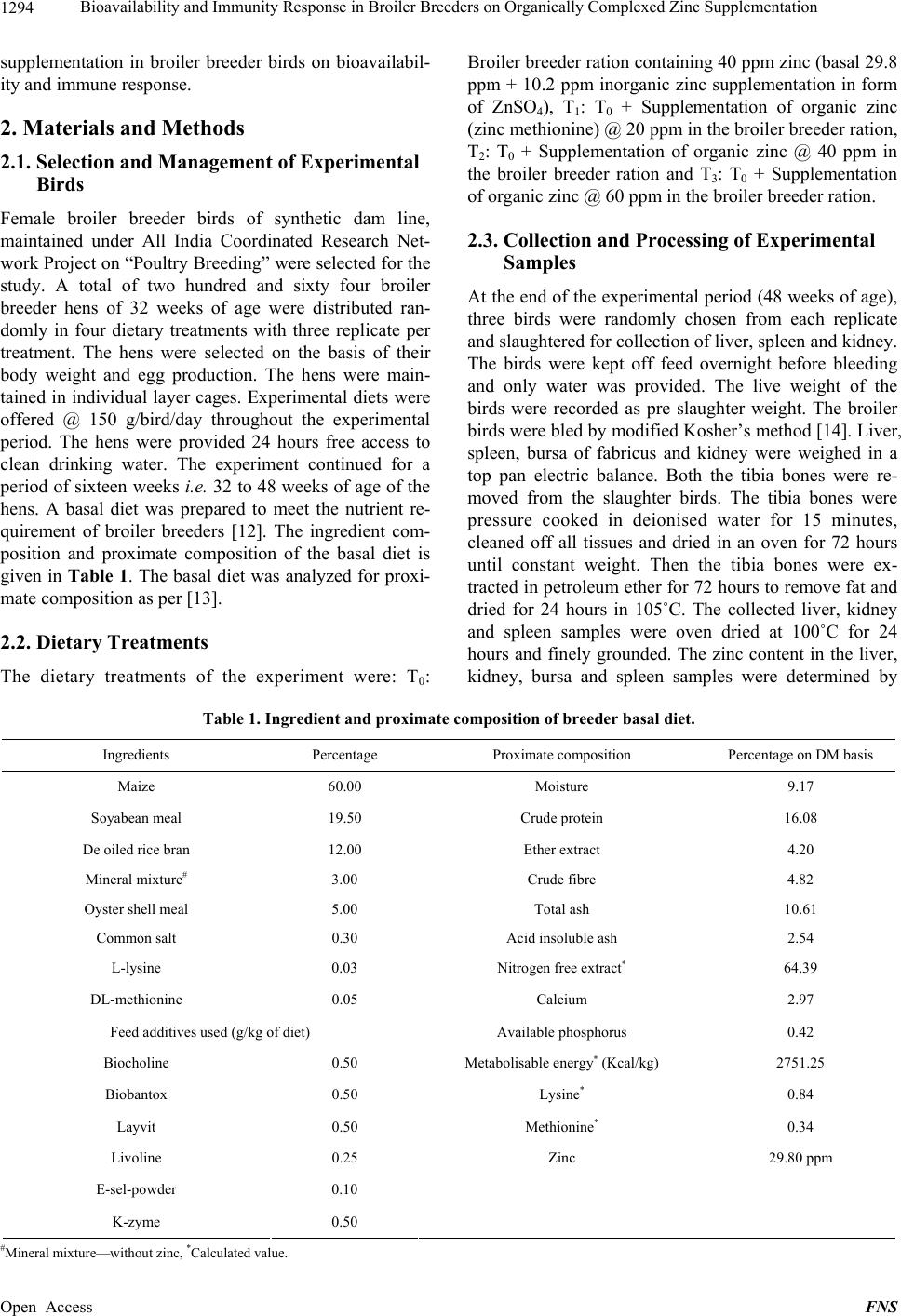 Bioavailability and Immunity Response in Broiler Breeders on Organically Complexed Zinc Supplementation 1294 supplementation in broiler breeder birds on bioavailabil- ity and immune response. 2. Materials and Methods 2.1. Selection and Management of Experimental Birds Female broiler breeder birds of synthetic dam line, maintained under All India Coordinated Research Net- work Project on “Poultry Breeding” were selected for the study. A total of two hundred and sixty four broiler breeder hens of 32 weeks of age were distributed ran- domly in four dietary treatments with three replicate per treatment. The hens were selected on the basis of their body weight and egg production. The hens were main- tained in individual layer cages. Experimental diets were offered @ 150 g/bird/day throughout the experimental period. The hens were provided 24 hours free access to clean drinking water. The experiment continued for a period of sixteen weeks i.e. 32 to 48 weeks of age of the hens. A basal diet was prepared to meet the nutrient re- quirement of broiler breeders [12]. The ingredient com- position and proximate composition of the basal diet is given in Table 1. The basal diet was analyzed for proxi- mate composition as per [13]. 2.2. Dietary Treatments The dietary treatments of the experiment were: T0: Broiler breeder ration containing 40 ppm zinc (basal 29.8 ppm + 10.2 ppm inorganic zinc supplementation in form of ZnSO4), T1: T0 + Supplementation of organic zinc (zinc methionine) @ 20 ppm in the broiler breeder ration, T2: T0 + Supplementation of organic zinc @ 40 ppm in the broiler breeder ration and T3: T0 + Supplementation of organic zinc @ 60 ppm in the broiler breeder ration. 2.3. Collection and Processing of Experimental Samples At the end of the experimental period (48 weeks of age), three birds were randomly chosen from each replicate and slaughtered for collection of liver, spleen and kidney. The birds were kept off feed overnight before bleeding and only water was provided. The live weight of the birds were recorded as pre slaughter weight. The broiler birds were bled by modified Kosher’s method [14]. Liver, spleen, bursa of fabricus and kidney were weighed in a top pan electric balance. Both the tibia bones were re- moved from the slaughter birds. The tibia bones were pressure cooked in deionised water for 15 minutes, cleaned off all tissues and dried in an oven for 72 hours until constant weight. Then the tibia bones were ex- tracted in petroleum ether for 72 hours to remove fat and dried for 24 hours in 105˚C. The collected liver, kidney and spleen samples were oven dried at 100˚C for 24 hours and finely grounded. The zinc content in the liver, kidney, bursa and spleen samples were determined by Table 1. Ingredient and proximate composition of breeder basal diet. Ingredients Percentage Proximate composition Percentage on DM basis Maize 60.00 Moisture 9.17 Soyabean meal 19.50 Crude protein 16.08 De oiled rice bran 12.00 Ether extract 4.20 Mineral mixture# 3.00 Crude fibre 4.82 Oyster shell meal 5.00 Total ash 10.61 Common salt 0.30 Acid insoluble ash 2.54 L-lysine 0.03 Nitrogen free extract* 64.39 DL-methionine 0.05 Calcium 2.97 Feed additives used (g/kg of diet) Available phosphorus 0.42 Biocholine 0.50 Metabolisable energy* (Kcal/kg) 2751.25 Biobantox 0.50 Lysine* 0.84 Layvit 0.50 Methionine* 0.34 Livoline 0.25 Zinc 29.80 ppm E-sel-powder 0.10 K-zyme 0.50 # Mineral mixture—without zinc, *Calculated value. Open Access FNS 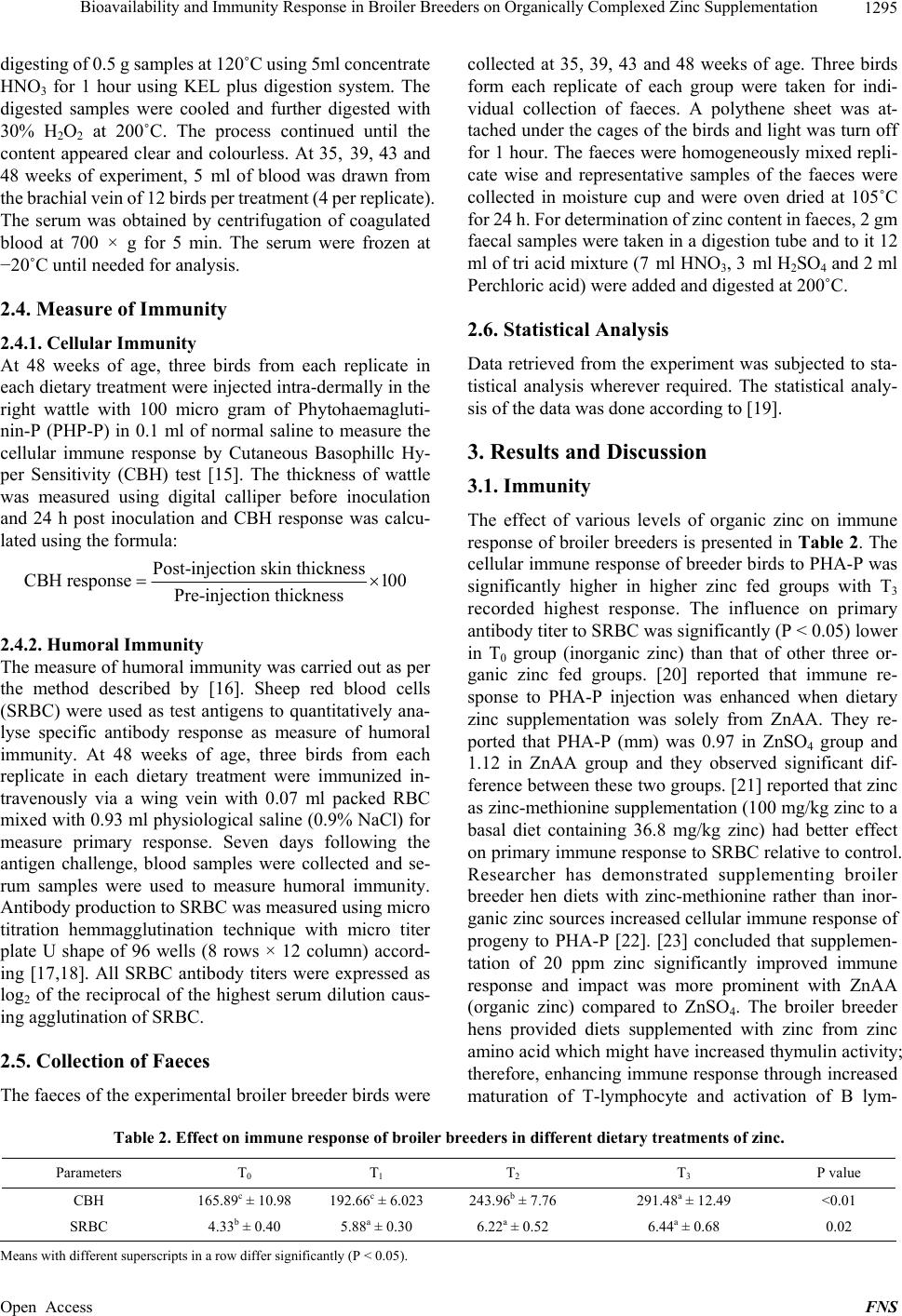 Bioavailability and Immunity Response in Broiler Breeders on Organically Complexed Zinc Supplementation 1295 digesting of 0.5 g samples at 120˚C using 5ml concentrate HNO3 for 1 hour using KEL plus digestion system. The digested samples were cooled and further digested with 30% H2O2 at 200˚C. The process continued until the content appeared clear and colourless. At 35, 39, 43 and 48 weeks of experiment, 5 ml of blood was drawn from the brachial vein of 12 birds per treatment (4 per replicate). The serum was obtained by centrifugation of coagulated blood at 700 × g for 5 min. The serum were frozen at −20˚C until needed for analysis. 2.4. Measure of Immunity 2.4.1. Cellular Immunity At 48 weeks of age, three birds from each replicate in each dietary treatment were injected intra-dermally in the right wattle with 100 micro gram of Phytohaemagluti- nin-P (PHP-P) in 0.1 ml of normal saline to measure the cellular immune response by Cutaneous Basophillc Hy- per Sensitivity (CBH) test [15]. The thickness of wattle was measured using digital calliper before inoculation and 24 h post inoculation and CBH response was calcu- lated using the formula: Post-injection skin thickness CBH response100 Pre-injection thickness 2.4.2. Humoral Immunity The measure of humoral immunity was carried out as per the method described by [16]. Sheep red blood cells (SRBC) were used as test antigens to quantitatively ana- lyse specific antibody response as measure of humoral immunity. At 48 weeks of age, three birds from each replicate in each dietary treatment were immunized in- travenously via a wing vein with 0.07 ml packed RBC mixed with 0.93 ml physiological saline (0.9% NaCl) for measure primary response. Seven days following the antigen challenge, blood samples were collected and se- rum samples were used to measure humoral immunity. Antibody production to SRBC was measured using micro titration hemmagglutination technique with micro titer plate U shape of 96 wells (8 rows × 12 column) accord- ing [17,18]. All SRBC antibody titers were expressed as log2 of the reciprocal of the highest serum dilution caus- ing agglutination of SRBC. 2.5. Collection of Faeces The faeces of the experimental broiler breeder birds were collected at 35, 39, 43 and 48 weeks of age. Three birds form each replicate of each group were taken for indi- vidual collection of faeces. A polythene sheet was at- tached under the cages of the birds and light was turn off for 1 hour. The faeces were homogeneously mixed repli- cate wise and representative samples of the faeces were collected in moisture cup and were oven dried at 105˚C for 24 h. For determination of zinc content in faeces, 2 gm faecal samples were taken in a digestion tube and to it 12 ml of tri acid mixture (7 ml HNO3, 3 ml H2SO4 and 2 ml Perchloric acid) were added and digested at 200˚C. 2.6. Statistical Analysis Data retrieved from the experiment was subjected to sta- tistical analysis wherever required. The statistical analy- sis of the data was done according to [19]. 3. Results and Discussion 3.1. Immunity The effect of various levels of organic zinc on immune response of broiler breeders is presented in Table 2. The cellular immune response of breeder birds to PHA-P was significantly higher in higher zinc fed groups with T3 recorded highest response. The influence on primary antibody titer to SRBC was significantly (P < 0.05) lower in T0 group (inorganic zinc) than that of other three or- ganic zinc fed groups. [20] reported that immune re- sponse to PHA-P injection was enhanced when dietary zinc supplementation was solely from ZnAA. They re- ported that PHA-P (mm) was 0.97 in ZnSO4 group and 1.12 in ZnAA group and they observed significant dif- ference between these two groups. [21] reported that zinc as zinc-methionine supplementation (100 mg/kg zinc to a basal diet containing 36.8 mg/kg zinc) had better effect on primary immune response to SRBC relative to control. Researcher has demonstrated supplementing broiler breeder hen diets with zinc-methionine rather than inor- ganic zinc sources increased cellular immune response of progeny to PHA-P [22]. [23] concluded that supplemen- tation of 20 ppm zinc significantly improved immune response and impact was more prominent with ZnAA (organic zinc) compared to ZnSO4. The broiler breeder hens provided diets supplemented with zinc from zinc amino acid which might have increased thymulin activity; therefore, enhancing immune response through increased maturation of T-lymphocyte and activation of B lym- Table 2. Effect on immune response of broiler breeders in different dietary treatments of zinc. Parameters T0 T 1 T 2 T 3 P value CBH 165.89c ± 10.98 192.66c ± 6.023 243.96b ± 7.76 291.48a ± 12.49 <0.01 SRBC 4.33b ± 0.40 5.88a ± 0.30 6.22a ± 0.52 6.44a ± 0.68 0.02 Means with different superscripts in a row differ significantly (P < 0.05). Open Access FNS 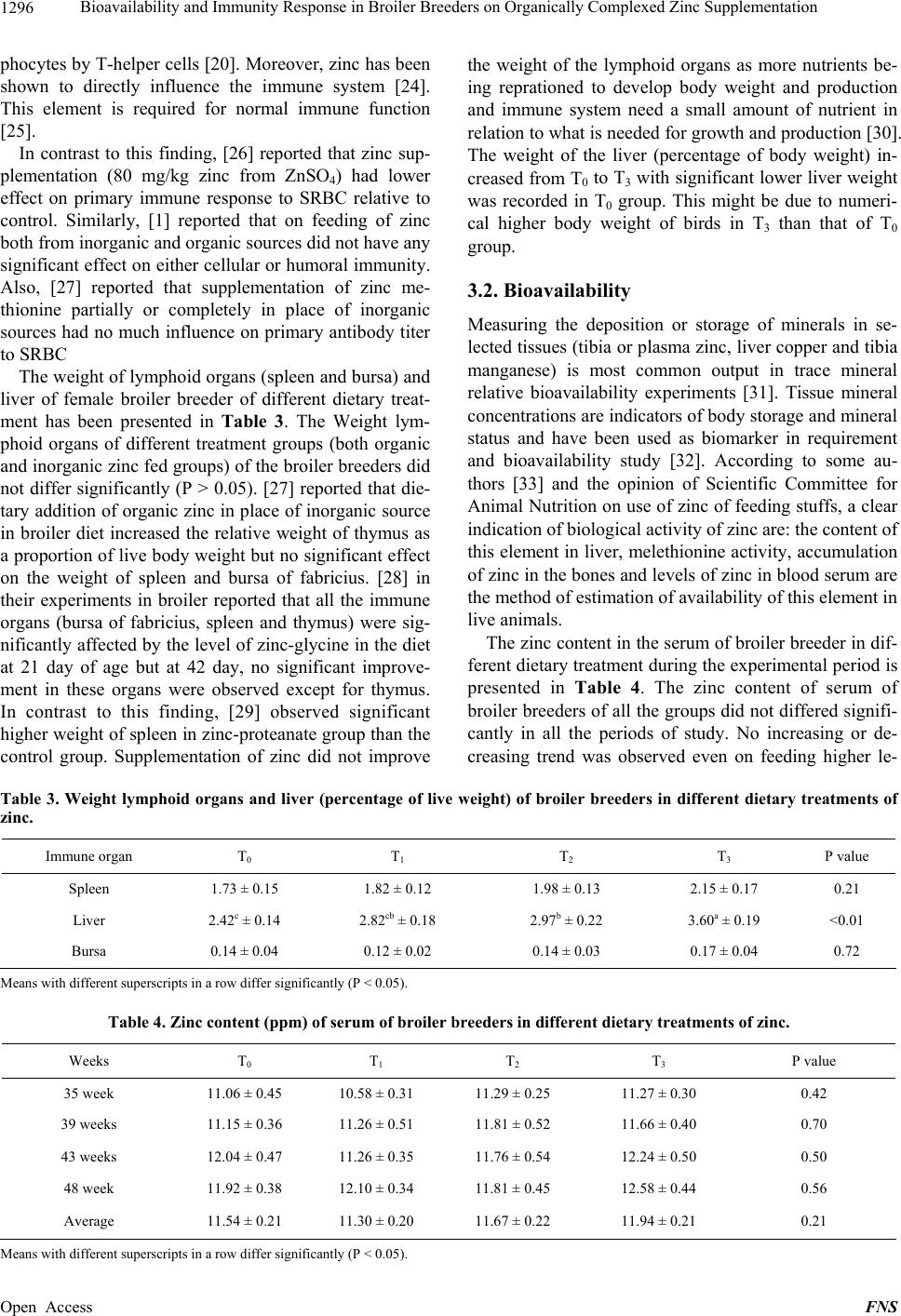 Bioavailability and Immunity Response in Broiler Breeders on Organically Complexed Zinc Supplementation 1296 phocytes by T-helper cells [20]. Moreover, zinc has been shown to directly influence the immune system [24]. This element is required for normal immune function [25]. In contrast to this finding, [26] reported that zinc sup- plementation (80 mg/kg zinc from ZnSO4) had lower effect on primary immune response to SRBC relative to control. Similarly, [1] reported that on feeding of zinc both from inorganic and organic sources did not have any significant effect on either cellular or humoral immunity. Also, [27] reported that supplementation of zinc me- thionine partially or completely in place of inorganic sources had no much influence on primary antibody titer to SRBC The weight of lymphoid organs (spleen and bursa) and liver of female broiler breeder of different dietary treat- ment has been presented in Table 3. The Weight lym- phoid organs of different treatment groups (both organic and inorganic zinc fed groups) of the broiler breeders did not differ significantly (P > 0.05). [27] reported that die- tary addition of organic zinc in place of inorganic source in broiler diet increased the relative weight of thymus as a proportion of live body weight but no significant effect on the weight of spleen and bursa of fabricius. [28] in their experiments in broiler reported that all the immune organs (bursa of fabricius, spleen and thymus) were sig- nificantly affected by the level of zinc-glycine in the diet at 21 day of age but at 42 day, no significant improve- ment in these organs were observed except for thymus. In contrast to this finding, [29] observed significant higher weight of spleen in zinc-proteanate group than the control group. Supplementation of zinc did not improve the weight of the lymphoid organs as more nutrients be- ing reprationed to develop body weight and production and immune system need a small amount of nutrient in relation to what is needed for growth and production [30]. The weight of the liver (percentage of body weight) in- creased from T0 to T3 with significant lower liver weight was recorded in T0 group. This might be due to numeri- cal higher body weight of birds in T3 than that of T0 group. 3.2. Bioavailability Measuring the deposition or storage of minerals in se- lected tissues (tibia or plasma zinc, liver copper and tibia manganese) is most common output in trace mineral relative bioavailability experiments [31]. Tissue mineral concentrations are indicators of body storage and mineral status and have been used as biomarker in requirement and bioavailability study [32]. According to some au- thors [33] and the opinion of Scientific Committee for Animal Nutrition on use of zinc of feeding stuffs, a clear indication of biological activity of zinc are: the content of this element in liver, melethionine activity, accumulation of zinc in the bones and levels of zinc in blood serum are the method of estimation of availability of this element in live animals. The zinc content in the serum of broiler breeder in dif- ferent dietary treatment during the experimental period is presented in Table 4. The zinc content of serum of broiler breeders of all the groups did not differed signifi- cantly in all the periods of study. No increasing or de- creasing trend was observed even on feeding higher le- Table 3. Weight lymphoid organs and liver (percentage of live weight) of broiler breeders in different dietary treatments of zinc. Immune organ T0 T 1 T 2 T 3 P value Spleen 1.73 ± 0.15 1.82 ± 0.12 1.98 ± 0.13 2.15 ± 0.17 0.21 Liver 2.42c ± 0.14 2.82cb ± 0.18 2.97b ± 0.22 3.60a ± 0.19 <0.01 Bursa 0.14 ± 0.04 0.12 ± 0.02 0.14 ± 0.03 0.17 ± 0.04 0.72 Means with different superscripts in a row differ significantly (P < 0.05). Table 4. Zinc content (ppm) of serum of broiler breeders in different dietary treatments of zinc. Weeks T0 T 1 T 2 T 3 P value 35 week 11.06 ± 0.45 10.58 ± 0.31 11.29 ± 0.25 11.27 ± 0.30 0.42 39 weeks 11.15 ± 0.36 11.26 ± 0.51 11.81 ± 0.52 11.66 ± 0.40 0.70 43 weeks 12.04 ± 0.47 11.26 ± 0.35 11.76 ± 0.54 12.24 ± 0.50 0.50 48 week 11.92 ± 0.38 12.10 ± 0.34 11.81 ± 0.45 12.58 ± 0.44 0.56 Average 11.54 ± 0.21 11.30 ± 0.20 11.67 ± 0.22 11.94 ± 0.21 0.21 M eans with different superscripts in a row differ significantly (P < 0.05). Open Access FNS  Bioavailability and Immunity Response in Broiler Breeders on Organically Complexed Zinc Supplementation 1297 vels of zinc in organic form or replacement of inorganic zinc with organic zinc in the diet of broiler breeders. [34] in their experiment on broilers reported that zinc content of serum of both organic and inorganic fed groups did not differ significantly which is in agreement with our finding. In contrast to this, [29] reported significantly higher level of serum zinc in zinc-proteanate group than control. Similarly, [35] reported that broiler chicken re- ceived diet containing zinc-methionine had increased level serum zinc compared to the content of this element in birds received zinc sulphate. The non-significant level of serum zinc in different periods of study might be due to mineral homeostasis which is precisely maintained in the body and is predominantly achieved by balancing tissue storage and excretion [36]. Zinc content in liver, tibia, kidney and spleen of broiler breeders in different dietary treatments is pre- sented in Table 5. Zinc content in liver and tibia of broiler breeders in different dietary treatments of zinc differed significantly (P < 0.05) with higher levels ob- tained on increasing zinc concentration in the diet. The increased level of zinc in tibia as observed in the present study is in agreement with the findings of [29,34,35, 37,38]. In contrast to this finding, [39] reported dietary treatment by replacing 50% of the inorganic Zn, Cu, Mn in the control ration with chelated minerals at 14 and 52 day, there was no significant difference between the con- trol and treatment group for tibia zinc content. This might be due to lower duration of feeding. [26] reported that feeding broiler chicken with feed containing either zinc-methionine or ZnO had no significant effect on the presence of microelements in the bone. Moreover, based on tibia zinc content, [11] reported that zinc from zinc methionine, is more bio-available than zinc from ZnSO4 or ZnO. Similarly, [9] reported the impact of different die- tary concentrations of minerals on their deposition rate in tibia. Their results showed that with feeding different diets containing same concentration of zinc, manganese and copper, birds were able to deposit organic form of minerals more efficient than their inorganic form. [37] reported that the increased dietary addition of zinc from both organic and inorganic sources increased the liver zinc content. [40] reported that on supplementation of 100 ppm zn-methionine chelate over the NRC level in control group exhibited higher zinc content in the liver (104.53 ppm) of zinc-methionine supplemented group than control (99.50 ppm) in spite of any significant dif- ference between the two groups. In support to our finding, [26] reported that feeding broiler chicken with feed con- taining either zinc-methionine or ZnO had no significant effect on the presence of microelements in the liver and pancreas at the same level of feeding but they observed significant difference in zinc levels of those organs at different levels of feeding. The zinc level in the spleen and kidney of the broiler breeders in different dietary treatments did not differ significantly. No such reported work was available on this study. Probably, the weight of immune organ have significance in birds on feeding different source and level of zinc rather than the level of zinc in those organs. 3.3. Faecal Excretion The zinc content in the faeces of broiler breeder in dif- ferent dietary treatment during the experimental period has been presented in Table 6. The zinc content in the faeces (excretion) of broiler breeders in different dietary treatments of zinc did not differ significantly among all the treatments during the periods of study viz. 32 - 35 weeks, 36 - 39 weeks and 40 - 43 weeks of age. Even the zinc level was higher in T3 and T2 but the zinc excretion was not significant which implied better bioavailability of organic zinc. [41] reported that one of the benefits of feeding chelated minerals to broilers was to improve mineral bioavailability, allowing reduction in dietary mineral supplementation and thus reduced excretion. Organically complexed trace minerals provide alternative pathways for absorption, thus leading to a reduction in the excretion of minerals [42]. But during 44 - 48 weeks of age, the zinc excretion in faeces was significantly higher in T3 than that of T2, T1 and T0 groups. The over- all zinc excretion in faeces of T3 did not differ signifi- cantly with T2 which implied higher retention of zinc in T3 as it contained 20 ppm which is more organic zinc Table 5. Zinc content (ppm) in organs and chicks of broiler breeders in different dietary treatments of zinc. Organs T0 T 1 T 2 T 3 P value Liver 75.76c ± 2.28 83.37bc ± 3.29 90.92b ± 3.27 106.12a ± 3.065 <0.01 Kidney 91.65 ± 1.184 89.85 ± 0.82 90.51 ± 0.89 92.73 ± 0.74 0.15 Spleen 85.62 ± 1.43 82.33 ± 1.68 84.89 ± 2.51 85.69 ± 1.72 0.56 Tibia 203.0c ± 9.54 320.81b ± 16.71 375.22a ± 12.98 381.84a ± 13.99 <0.01 chick 55.25d ± 1.51 59.38c ± 1.37 65.6b ± 1.43 71.81a ± 0.97 <0.01 Means with different superscripts in a row differ significantly (P < 0.05). Open Access FNS 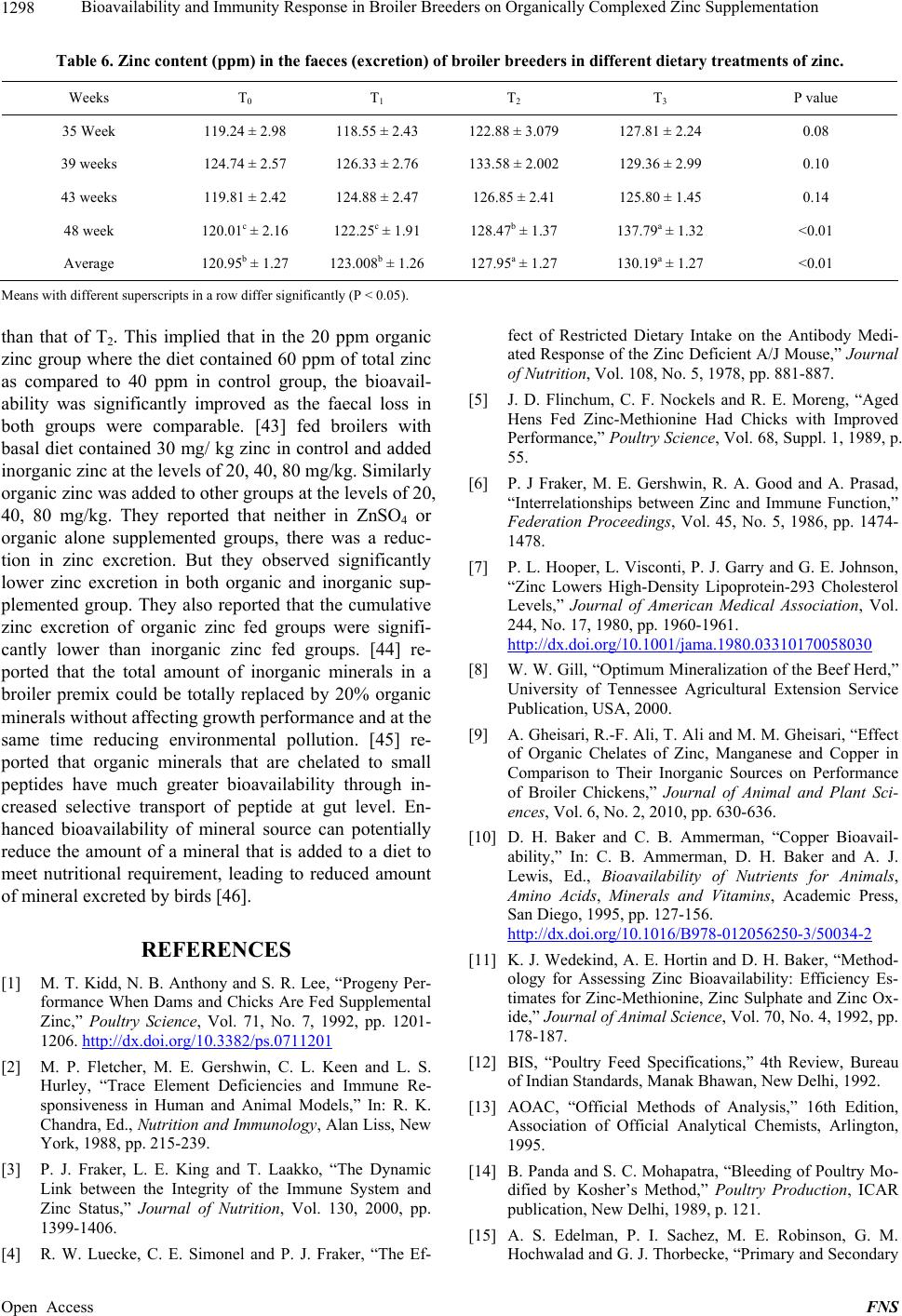 Bioavailability and Immunity Response in Broiler Breeders on Organically Complexed Zinc Supplementation 1298 Table 6. Zinc content (ppm) in the faeces (excretion) of broiler breeders in different dietary treatments of zinc. Weeks T0 T 1 T 2 T 3 P value 35 Week 119.24 ± 2.98 118.55 ± 2.43 122.88 ± 3.079 127.81 ± 2.24 0.08 39 weeks 124.74 ± 2.57 126.33 ± 2.76 133.58 ± 2.002 129.36 ± 2.99 0.10 43 weeks 119.81 ± 2.42 124.88 ± 2.47 126.85 ± 2.41 125.80 ± 1.45 0.14 48 week 120.01c ± 2.16 122.25c ± 1.91 128.47b ± 1.37 137.79a ± 1.32 <0.01 Average 120.95b ± 1.27 123.008b ± 1.26 127.95a ± 1.27 130.19a ± 1.27 <0.01 Means with different superscripts in a row differ significantly (P < 0.05). than that of T2. This implied that in the 20 ppm organic zinc group where the diet contained 60 ppm of total zinc as compared to 40 ppm in control group, the bioavail- ability was significantly improved as the faecal loss in both groups were comparable. [43] fed broilers with basal diet contained 30 mg/ kg zinc in control and added inorganic zinc at the levels of 20, 40, 80 mg/kg. Similarly organic zinc was added to other groups at the levels of 20, 40, 80 mg/kg. They reported that neither in ZnSO4 or organic alone supplemented groups, there was a reduc- tion in zinc excretion. But they observed significantly lower zinc excretion in both organic and inorganic sup- plemented group. They also reported that the cumulative zinc excretion of organic zinc fed groups were signifi- cantly lower than inorganic zinc fed groups. [44] re- ported that the total amount of inorganic minerals in a broiler premix could be totally replaced by 20% organic minerals without affecting growth performance and at the same time reducing environmental pollution. [45] re- ported that organic minerals that are chelated to small peptides have much greater bioavailability through in- creased selective transport of peptide at gut level. En- hanced bioavailability of mineral source can potentially reduce the amount of a mineral that is added to a diet to meet nutritional requirement, leading to reduced amount of mineral excreted by birds [46]. REFERENCES [1] M. T. Kidd, N. B. Anthony and S. R. Lee, “Progeny Per- formance When Dams and Chicks Are Fed Supplemental Zinc,” Poultry Science, Vol. 71, No. 7, 1992, pp. 1201- 1206. http://dx.doi.org/10.3382/ps.0711201 [2] M. P. Fletcher, M. E. Gershwin, C. L. Keen and L. S. Hurley, “Trace Element Deficiencies and Immune Re- sponsiveness in Human and Animal Models,” In: R. K. Chandra, Ed., Nutrition and Immunology, Alan Liss, New York, 1988, pp. 215-239. [3] P. J. Fraker, L. E. King and T. Laakko, “The Dynamic Link between the Integrity of the Immune System and Zinc Status,” Journal of Nutrition, Vol. 130, 2000, pp. 1399-1406. [4] R. W. Luecke, C. E. Simonel and P. J. Fraker, “The Ef- fect of Restricted Dietary Intake on the Antibody Medi- ated Response of the Zinc Deficient A/J Mouse,” Journal of Nutrition, Vol. 108, No. 5, 1978, pp. 881-887. [5] J. D. Flinchum, C. F. Nockels and R. E. Moreng, “Aged Hens Fed Zinc-Methionine Had Chicks with Improved Performance,” Poultry Science , Vol. 68, Suppl. 1, 1989, p. 55. [6] P. J Fraker, M. E. Gershwin, R. A. Good and A. Prasad, “Interrelationships between Zinc and Immune Function,” Federation Proceedings, Vol. 45, No. 5, 1986, pp. 1474- 1478. [7] P. L. Hooper, L. Visconti, P. J. Garry and G. E. Johnson, “Zinc Lowers High-Density Lipoprotein-293 Cholesterol Levels,” Journal of American Medical Association, Vol. 244, No. 17, 1980, pp. 1960-1961. http://dx.doi.org/10.1001/jama.1980.03310170058030 [8] W. W. Gill, “Optimum Mineralization of the Beef Herd,” University of Tennessee Agricultural Extension Service Publication, USA, 2000. [9] A. Gheisari, R.-F. Ali, T. Ali and M. M. Gheisari, “Effect of Organic Chelates of Zinc, Manganese and Copper in Comparison to Their Inorganic Sources on Performance of Broiler Chickens,” Journal of Animal and Plant Sci- ences, Vol. 6, No. 2, 2010, pp. 630-636. [10] D. H. Baker and C. B. Ammerman, “Copper Bioavail- ability,” In: C. B. Ammerman, D. H. Baker and A. J. Lewis, Ed., Bioavailability of Nutrients for Animals, Amino Acids, Minerals and Vitamins, Academic Press, San Diego, 1995, pp. 127-156. http://dx.doi.org/10.1016/B978-012056250-3/50034-2 [11] K. J. Wedekind, A. E. Hortin and D. H. Baker, “Method- ology for Assessing Zinc Bioavailability: Efficiency Es- timates for Zinc-Methionine, Zinc Sulphate and Zinc Ox- ide,” Journal of Animal Science, Vol. 70, No. 4, 1992, pp. 178-187. [12] BIS, “Poultry Feed Specifications,” 4th Review, Bureau of Indian Standards, Manak Bhawan, New Delhi, 1992. [13] AOAC, “Official Methods of Analysis,” 16th Edition, Association of Official Analytical Chemists, Arlington, 1995. [14] B. Panda and S. C. Mohapatra, “Bleeding of Poultry Mo- dified by Kosher’s Method,” Poultry Production, ICAR publication, New Delhi, 1989, p. 121. [15] A. S. Edelman, P. I. Sachez, M. E. Robinson, G. M. Hochwalad and G. J. Thorbecke, “Primary and Secondary Open Access FNS 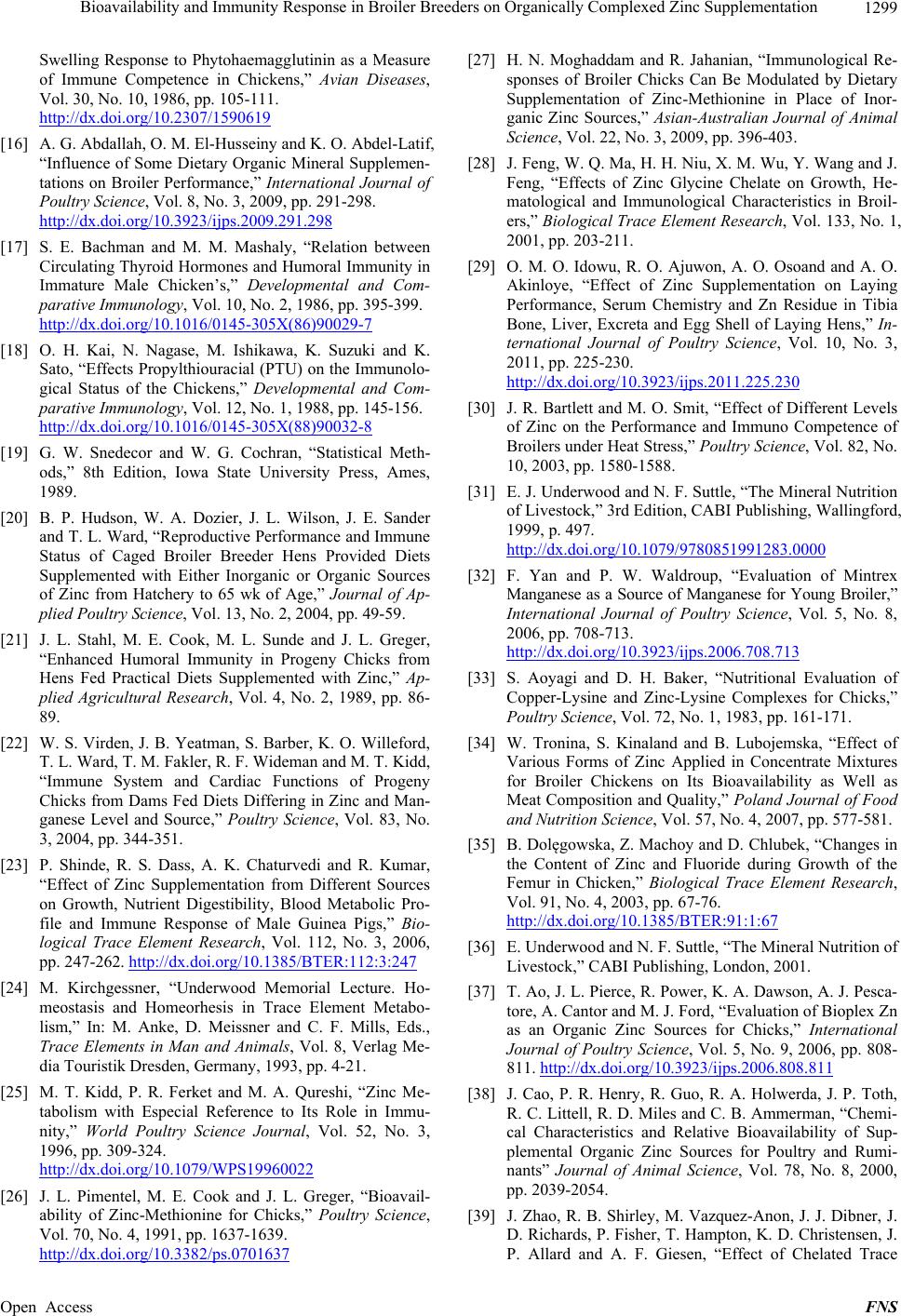 Bioavailability and Immunity Response in Broiler Breeders on Organically Complexed Zinc Supplementation 1299 Swelling Response to Phytohaemagglutinin as a Measure of Immune Competence in Chickens,” Avian Diseases, Vol. 30, No. 10, 1986, pp. 105-111. http://dx.doi.org/10.2307/1590619 [16] A. G. Abdallah, O. M. El-Husseiny and K. O. Abdel-Latif, “Influence of Some Dietary Organic Mineral Supplemen- tations on Broiler Performance,” International Journal of Poultry Science, Vol. 8, No. 3, 2009, pp. 291-298. http://dx.doi.org/10.3923/ijps.2009.291.298 [17] S. E. Bachman and M. M. Mashaly, “Relation between Circulating Thyroid Hormones and Humoral Immunity in Immature Male Chicken’s,” Developmental and Com- parative Immunology, Vol. 10, No. 2, 1986, pp. 395-399. http://dx.doi.org/10.1016/0145-305X(86)90029-7 [18] O. H. Kai, N. Nagase, M. Ishikawa, K. Suzuki and K. Sato, “Effects Propylthiouracial (PTU) on the Immunolo- gical Status of the Chickens,” Developmental and Com- parative Immunology, Vol. 12, No. 1, 1988, pp. 145-156. http://dx.doi.org/10.1016/0145-305X(88)90032-8 [19] G. W. Snedecor and W. G. Cochran, “Statistical Meth- ods,” 8th Edition, Iowa State University Press, Ames, 1989. [20] B. P. Hudson, W. A. Dozier, J. L. Wilson, J. E. Sander and T. L. Ward, “Reproductive Performance and Immune Status of Caged Broiler Breeder Hens Provided Diets Supplemented with Either Inorganic or Organic Sources of Zinc from Hatchery to 65 wk of Age,” Journal of Ap- plied Poultry Science, Vol. 13, No. 2, 2004, pp. 49-59. [21] J. L. Stahl, M. E. Cook, M. L. Sunde and J. L. Greger, “Enhanced Humoral Immunity in Progeny Chicks from Hens Fed Practical Diets Supplemented with Zinc,” Ap- plied Agricultural Research, Vol. 4, No. 2, 1989, pp. 86- 89. [22] W. S. Virden, J. B. Yeatman, S. Barber, K. O. Willeford, T. L. Ward, T. M. Fakler, R. F. Wideman and M. T. Kidd, “Immune System and Cardiac Functions of Progeny Chicks from Dams Fed Diets Differing in Zinc and Man- ganese Level and Source,” Poultry Science, Vol. 83, No. 3, 2004, pp. 344-351. [23] P. Shinde, R. S. Dass, A. K. Chaturvedi and R. Kumar, “Effect of Zinc Supplementation from Different Sources on Growth, Nutrient Digestibility, Blood Metabolic Pro- file and Immune Response of Male Guinea Pigs,” Bio- logical Trace Element Research, Vol. 112, No. 3, 2006, pp. 247-262. http://dx.doi.org/10.1385/BTER:112:3:247 [24] M. Kirchgessner, “Underwood Memorial Lecture. Ho- meostasis and Homeorhesis in Trace Element Metabo- lism,” In: M. Anke, D. Meissner and C. F. Mills, Eds., Trace Elements in Man and Animals, Vol. 8, Verlag Me- dia Touristik Dresden, Germany, 1993, pp. 4-21. [25] M. T. Kidd, P. R. Ferket and M. A. Qureshi, “Zinc Me- tabolism with Especial Reference to Its Role in Immu- nity,” World Poultry Science Journal, Vol. 52, No. 3, 1996, pp. 309-324. http://dx.doi.org/10.1079/WPS19960022 [26] J. L. Pimentel, M. E. Cook and J. L. Greger, “Bioavail- ability of Zinc-Methionine for Chicks,” Poultry Science, Vol. 70, No. 4, 1991, pp. 1637-1639. http://dx.doi.org/10.3382/ps.0701637 [27] H. N. Moghaddam and R. Jahanian, “Immunological Re- sponses of Broiler Chicks Can Be Modulated by Dietary Supplementation of Zinc-Methionine in Place of Inor- ganic Zinc Sources,” Asian-Australian Journal of Animal Science, Vol. 22, No. 3, 2009, pp. 396-403. [28] J. Feng, W. Q. Ma, H. H. Niu, X. M. Wu, Y. Wang and J. Feng, “Effects of Zinc Glycine Chelate on Growth, He- matological and Immunological Characteristics in Broil- ers,” Biological Trace Element Research, Vol. 133, No. 1, 2001, pp. 203-211. [29] O. M. O. Idowu, R. O. Ajuwon, A. O. Osoand and A. O. Akinloye, “Effect of Zinc Supplementation on Laying Performance, Serum Chemistry and Zn Residue in Tibia Bone, Liver, Excreta and Egg Shell of Laying Hens,” In- ternational Journal of Poultry Science, Vol. 10, No. 3, 2011, pp. 225-230. http://dx.doi.org/10.3923/ijps.2011.225.230 [30] J. R. Bartlett and M. O. Smit, “Effect of Different Levels of Zinc on the Performance and Immuno Competence of Broilers under Heat Stress,” Poultry Science, Vol. 82, No. 10, 2003, pp. 1580-1588. [31] E. J. Underwood and N. F. Suttle, “The Mineral Nutrition of Livestock,” 3rd Edition, CABI Publishing, Wallingford, 1999, p. 497. http://dx.doi.org/10.1079/9780851991283.0000 [32] F. Yan and P. W. Waldroup, “Evaluation of Mintrex Manganese as a Source of Manganese for Young Broiler,” International Journal of Poultry Science, Vol. 5, No. 8, 2006, pp. 708-713. http://dx.doi.org/10.3923/ijps.2006.708.713 [33] S. Aoyagi and D. H. Baker, “Nutritional Evaluation of Copper-Lysine and Zinc-Lysine Complexes for Chicks,” Poultry Science, Vol. 72, No. 1, 1983, pp. 161-171. [34] W. Tronina, S. Kinaland and B. Lubojemska, “Effect of Various Forms of Zinc Applied in Concentrate Mixtures for Broiler Chickens on Its Bioavailability as Well as Meat Composition and Quality,” Poland Journal of Food and Nutrition Science, Vol. 57, No. 4, 2007, pp. 577-581. [35] B. Dolęgowska, Z. Machoy and D. Chlubek, “Changes in the Content of Zinc and Fluoride during Growth of the Femur in Chicken,” Biological Trace Element Research, Vol. 91, No. 4, 2003, pp. 67-76. http://dx.doi.org/10.1385/BTER:91:1:67 [36] E. Underwood and N. F. Suttle, “The Mineral Nutrition of Livestock,” CABI Publishing, London, 2001. [37] T. Ao, J. L. Pierce, R. Power, K. A. Dawson, A. J. Pesca- tore, A. Cantor and M. J. Ford, “Evaluation of Bioplex Zn as an Organic Zinc Sources for Chicks,” International Journal of Poultry Science, Vol. 5, No. 9, 2006, pp. 808- 811. http://dx.doi.org/10.3923/ijps.2006.808.811 [38] J. Cao, P. R. Henry, R. Guo, R. A. Holwerda, J. P. Toth, R. C. Littell, R. D. Miles and C. B. Ammerman, “Chemi- cal Characteristics and Relative Bioavailability of Sup- plemental Organic Zinc Sources for Poultry and Rumi- nants” Journal of Animal Science, Vol. 78, No. 8, 2000, pp. 2039-2054. [39] J. Zhao, R. B. Shirley, M. Vazquez-Anon, J. J. Dibner, J. D. Richards, P. Fisher, T. Hampton, K. D. Christensen, J. P. Allard and A. F. Giesen, “Effect of Chelated Trace Open Access FNS 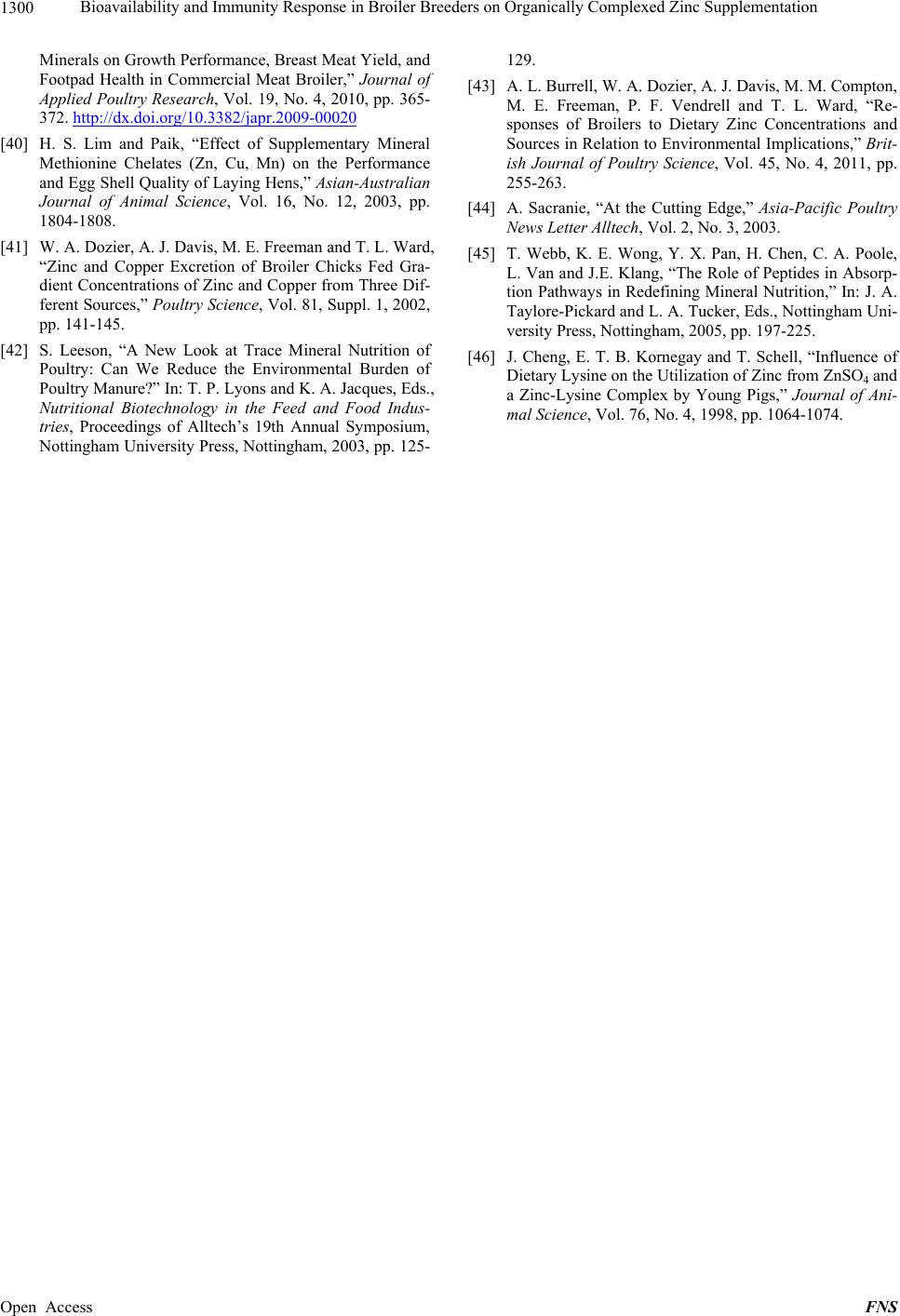 Bioavailability and Immunity Response in Broiler Breeders on Organically Complexed Zinc Supplementation Open Access FNS 1300 Minerals on Growth Performance, Breast Meat Yield, and Footpad Health in Commercial Meat Broiler,” Journal of Applied Poultry Research, Vol. 19, No. 4, 2010, pp. 365- 372. http://dx.doi.org/10.3382/japr.2009-00020 [40] H. S. Lim and Paik, “Effect of Supplementary Mineral Methionine Chelates (Zn, Cu, Mn) on the Performance and Egg Shell Quality of Laying Hens,” Asian-Australian Journal of Animal Science, Vol. 16, No. 12, 2003, pp. 1804-1808. [41] W. A. Dozier, A. J. Davis, M. E. Freeman and T. L. Ward, “Zinc and Copper Excretion of Broiler Chicks Fed Gra- dient Concentrations of Zinc and Copper from Three Dif- ferent Sources,” Poultry Science, Vol. 81, Suppl. 1, 2002, pp. 141-145. [42] S. Leeson, “A New Look at Trace Mineral Nutrition of Poultry: Can We Reduce the Environmental Burden of Poultry Manure?” In: T. P. Lyons and K. A. Jacques, Eds., Nutritional Biotechnology in the Feed and Food Indus- tries, Proceedings of Alltech’s 19th Annual Symposium, Nottingham University Press, Nottingham, 2003, pp. 125- 129. [43] A. L. Burrell, W. A. Dozier, A. J. Davis, M. M. Compton, M. E. Freeman, P. F. Vendrell and T. L. Ward, “Re- sponses of Broilers to Dietary Zinc Concentrations and Sources in Relation to Environmental Implications,” Brit- ish Journal of Poultry Science, Vol. 45, No. 4, 2011, pp. 255-263. [44] A. Sacranie, “At the Cutting Edge,” Asia-Pacific Poultry News Letter Alltech, Vol. 2, No. 3, 2003. [45] T. Webb, K. E. Wong, Y. X. Pan, H. Chen, C. A. Poole, L. Van and J.E. Klang, “The Role of Peptides in Absorp- tion Pathways in Redefining Mineral Nutrition,” In: J. A. Taylore-Pickard and L. A. Tucker, Eds., Nottingham Uni- versity Press, Nottingham, 2005, pp. 197-225. [46] J. Cheng, E. T. B. Kornegay and T. Schell, “Influence of Dietary Lysine on the Utilization of Zinc from ZnSO4 and a Zinc-Lysine Complex by Young Pigs,” Journal of Ani- mal Science, Vol. 76, No. 4, 1998, pp. 1064-1074.
|